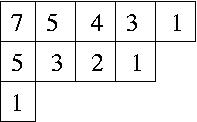Young tableau
|
|
In mathematics, a Young tableau is a combinatorial object useful in representation theory. It provides a convenient way to describe the group representations of the symmetric group and to study their properties.
Young tableaux were introduced by Alfred Young, a mathematician at Cambridge University in 1900. They were then applied to the study of symmetric group by Georg Frobenius in 1903. The theory was further developed by Alfred Young, in a sequence of papers — the last of which was published in 1952 — and by other mathematicians.
| Contents |
Definitions
Young diagram
Young_diagram_for_541_partition.jpg
The Young diagram for the partition 10 = 5 + 4 + 1
A Young diagram
A Young diagram (also called Ferrers diagram) is a way to represent partitions of a number n. Let n be a natural number. A partition is a way of expressing n as a sum of natural numbers: n = k1 + k2 + ... + km, where k1 ≥ k2 ≥ .... A partition can be described by a Young diagram which consists of m rows, with the first row containing k1 boxes, the second row containing k2 boxes, etc. Each row is left-justified.
Let's call this partition k (dropping the subscript, but remembering that it is there). Then the partition conjugate to k is the partition of n consisting of the count of boxes in each column. That is, for each Young diagram, there is a conjugate diagram which has the horizontal and vertical flipped on the 45-degree axis.
The figure on the right shows the Young diagram corresponding to the partition 10 = 5 + 4 + 1. The conjugate partition is 10 = 3 + 2 + 2 + 2 + 1.
Young tableau
Young_tableaux_for_541_partition.jpg
One of Young tableaux for the partition 10=5+4+1
A Young tableau
A Young tableau is obtained by taking a Young diagram and writing numbers 1, 2, ..., n into n boxes of this diagram, subject to the following constraints:
- in each row, the numbers must be increasing from the left to the right;
- in each column, the numbers must be increasing from the top to the bottom.
If each number appears in exactly one square, the tableau is called standard tableau. The variant where a number can appear in more than one square is sometimes called semi-standard tableau.
The figure on the right shows one of standard Young tableaux for the partition 10 = 5 + 4 + 1.
Applications in representation theory
Young diagrams are in one-to-one correspondence with irreducible representations of the symmetric group. They provide a convenient way of specifying the Young symmetrizers from which the irreducible representations are built. Many facts about a representation can be deduced from the corresponding diagram. Below, we describe two examples: determining the dimension of a representation and restricted representations. In both cases, we will see that some properties of a representation can be determined by using just its diagram.
Dimension of a representation
The dimension of a representation is equal to the number of different Young tableaux that can be obtained from the diagram of the representation. This number can be calculated by hook-length formula.
A hook length of a box in Young diagram is the number of boxes that are in the same row to the right of it or in the same column below it (including the box itself). By the hook-length formula the dimension of an irreducible representation is n! divided by the product of the hook lengths of all boxes in the diagram of the representation.
The figure on the right shows hook-lengths for all boxes in the diagram of the partition 10 = 5 + 4 + 1.
Restricted representations
A representation of the symmetric group on n elements, Sn is also a representation of the symmetric group on n − 1 elements, Sn−1. However, an irreducible representation of Sn may not be irreducible for Sn−1. Instead, it may be a direct sum of several representations that are irreducible for Sn−1. These representations are then called induced representations. The problem is to determine the induced representations, given a Young diagram for the representation of Sn.
The answer is that the induced representations are exactly the ones with Young diagrams which can be obtained by deleting one square from the Young diagram of the representation of Sn so that the result is still a valid diagram.
Constructing representations
Young tableaux can be also used to construct the representations of the symmetric group and to study their structure.
References
- William Fulton. Young Tableaux, with Applications to Representation Theory and Geometry. Cambridge University Press, 1997.
- William Fulton and Joe Harris, Representation Theory, A First Course (1991) Springer Verlag New York, ISBN 0-387-974495-4 See Chapter 4
- Bruce E. Sagan. The Symmetric Group. Springer, 2001.
External links
- Ferrers Diagram (http://mathworld.wolfram.com/FerrersDiagram.html) - from MathWorld
- Young Tableau (http://mathworld.wolfram.com/YoungTableau.html) - from MathWorld
- Alfred Young biography (http://www-gap.dcs.st-and.ac.uk/~history/Mathematicians/Young_Alfred.html) - from Mactutor

